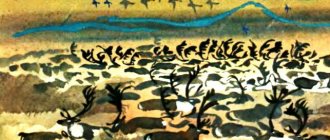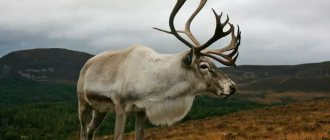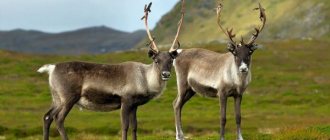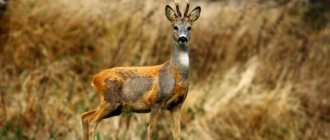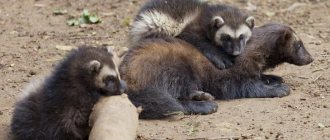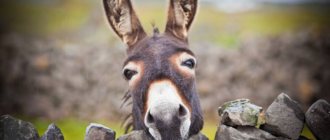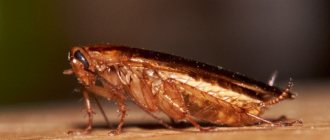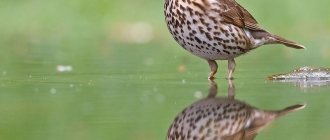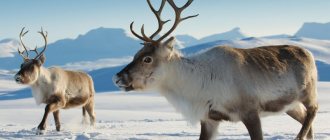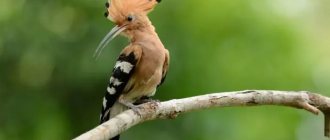Reindeer are artiodactyl mammals belonging to the deer family, living in North America and the northern part of Eurasia.
These animals are found in Karelia, Western Chukotka, the west of the Kola Peninsula and Kamchatka. There are also reindeer on Sakhalin. Animals are found in large numbers on the islands of the Arctic Ocean. In addition, they are residents of Canada and Alaska. The largest population is observed on the Taimyr Peninsula.
Reindeer (Rangifer tarandus).
The natural habitat of reindeer is forest-tundra, tundra and northern taiga; animals have felt comfortable in these harsh climatic zones for many thousands of years. In addition, reindeer have adapted well to plains and mountainous areas.
There are wild and domestic reindeer. Today there are much more domestic deer than wild ones.
Origin of the species and description
Photo: Reindeer
Reindeer (Rangifer tarandus) are very different from their counterparts, even in appearance. The first thing that attracts attention is the special shape of the horns, the owners of which are both males and females. It was previously believed that reindeer were native to North America, but over time, evidence of their early habitat was found in northern Europe.
Reindeer from the deer family belong to the class of mammals and the order of artiodactyls. Most individuals are located in the Northern Hemisphere. The body weight of the animal varies from 70 to 200 kg with sizes from 165 to 210 cm. Males of the species are relatively larger than females. Domesticated individuals live on average up to 15 years; in the wild, under favorable living conditions, this figure is higher.
The close proximity of an animal to a person leaves an imprint not only on the phenotype, but also on the habits and behavior of the deer. One of the most striking examples is the approach of danger; in nature, animals scatter, but domesticated ones, on the contrary, flock into a herd.
The physique of the reindeer is characterized by special elegance. Particular attention is drawn to the small size of the head and the slightly lowered position of the muzzle, where beautiful eyes stand out. The horns have a peculiar graceful curve. Animals tolerate low temperatures well due to their dense hair coat, which does not allow cold wind to pass through.
Enemies in nature
In nature, this ungulate often becomes prey for predatory animals:
- wolves;
- wolverines;
- bear
During their migration journeys, sick or weakened animals are at the end of the herd and become prey for predators.
Humans can also be counted among the enemies; until recently, these animals were mercilessly exterminated for the sake of their skins and horns.
Appearance and features
Photo: Animal reindeer
Reindeer are characterized by medium-sized bodies with an elongated shape. The neck is oblong and in appearance appears more massive and thick due to the thick hair covering, the height of which reaches 6 cm. At the same time, the legs are of medium length, but visually appear short. As noted, the animal’s muzzle is lowered down, which is why the silhouette looks less slender compared to other species of deer, and its movements are less graceful.
The deer's head is elongated, but of correct proportions, tapering towards the nose, which is also covered with a dense layer of hair and looks massive. The ears are round and small, no more than 18 cm in height. The eyes are almond-shaped. The length of the tail reaches 21 cm. It is noteworthy that domesticated individuals are smaller and lighter than their wild counterparts.
This species is distinguished by the fact that both males and females have horns. They are large in size and have an arched bend. Their span reaches 120 cm in males. The horns are always smooth, whitish in color, and light brown is also found. Reindeer, unlike others, have larger antlers, but their maximum weight is 12 kg.
Domestic specimens boast horns of more impressive size. The shape of the antlers is not repeated, no two deer have the same antlers, they differ in the number of branches, bending, thickness and size, even one deer does not have perfect symmetry on two antlers. Females have lighter horns than males.
From November to December, adult deer shed their antlers, while for young deer this process occurs from April to May. Females shed their horns from May to June; after calving, new ones begin to grow quite quickly, while for males it takes only three to four months.
Long and dense winter hair does not allow the cold to pass through and allows deer to easily endure the winter. The hair on the body, although thick and filled with air, is also quite brittle. On the legs, on the contrary, they are distinguished by endurance and short length. Due to the fact that long hair frames the hooves, the animal's supporting area increases, and this significantly reduces slipping.
In summer, the hairline changes to softer and shorter. The hair is slightly filled with air and the mane does not seem so voluminous. Summer color is uniform brown, with shades of ash, grayish or coffee. There are no particular differences in color between females and males. The hairline changes once a year, i.e. moulting occurs.
This process lasts quite a long time, it begins in April and ends in early August. The hairs of the old undercoat are shed first, followed by the awn. First, the head sheds, gradually the shedding moves to the back and ends on the belly.
Deer with character
"There in the blue moonlight
The white snow sparkles like during the day.
And the sled dashes dashingly downhill
Tiny eight deer"
This is an excerpt from the poem “A Visit from St. Nicholas” (aka “The Night Before Christmas”), written in 1823 by the American writer Clement Clarke Moore. It is believed that it was in this poem that Santa Claus' team first appears, and all the reindeer are named.
True, Moore has eight reindeer, and now there is one more in Santa’s sleigh. In addition, over the years since the poem was written, deer have acquired biographies, character traits and even hobbies (thanks to the authors of films, cartoons and modern fairy tales). And also hugely popular. Just one example: in the Canadian province of New Brunswick, mountain peaks are named after Santa’s reindeer.
Let's figure out who is included in the “magnificent eight” and where the ninth deer came from.
Deer Dasher
(Swift) was born at the North Pole. He, unlike his brothers, loves to compete in running, and in his free time he cleans his master's sleigh.
The name of his fellow countryman Dancer
(Dancer) speaks for itself: he constantly practices ballet steps, and sometimes gives concerts in front of the elves.
Prancer
(Skakun) is a merry fellow by nature, loves hide and seek, and is responsible for the Christmas leisure time of his brothers.
Vixen girl
(Frisky) – neat and tidy. He monitors not only his own appearance, but also the appearance of his “colleagues,” which sometimes irritates them terribly.
Vixen has an affair with Cupid the
. He was born on Valentine's Day and that's probably why he tries to arrange the personal lives of all the deer in the world. They say he even publishes a newspaper at the North Pole with dating advertisements.
Name Comet
It was no coincidence that one of the youngest reindeer in the team was born - he was born when Comet Blorius passed across the sky. So far, Comet is behaving like a diligent student and is gaining wisdom from his older brothers.
Donder
(Grom) is so experienced that he even works part-time as an instructor in special reindeer training and monitors the physical fitness of his comrades.
Blitzen
(Lightning) is a brave and courageous deer (one might say extreme), and also a football lover.
The Ninth Reindeer, Rudolph
, appeared in the harness also thanks to a literary work. In 1939, the American poet Robert May decided to write his own tale about Santa's reindeer - in which Rudolph Red Nose was mentioned for the first time. He was taken into the harness after the “guiding” luminous nose showed the way to Santa Claus in the darkness and thick fog. Very soon Rudolph became the most popular, and perhaps the most important of Santa's reindeer. And he gained particular fame after the cartoon “Rudolph the Reindeer” was made about him in 1964.
Dozens of films are dedicated to Santa Claus's magical team. In many of them, new characters appear - adult and little deer, who by chance become Santa's helpers. True, none of them have yet succeeded in “squeezing out” the members of the classic reindeer team.
Where do reindeer live?
Photo: Reindeer in the tundra
Reindeer have chosen large territories. Today they live in Norway, on the territory of the Kola Peninsula, in the taiga from Karelia to the Okhotsk coast. About 700 thousand individuals live in the wild in the tundra zone.
The largest concentration of deer is located on the Taimyr Peninsula - approximately 450 thousand individuals. Here reindeer migrations begin at the end of summer; they swim into the forest-tundra, and at the beginning of summer they return to the tundra again. Reindeer are also found in Transbaikalia and Altai.
Basically, reindeer prefer the climate of the following regions:
- Siberia;
- North America;
- Northern Europe.
In summer they live in areas of the Arctic coast. It is here that they escape the heat and annoying midges, which are especially active in the summer. As winter and cold weather approach, deer move into the forests. They prefer places where there is not a lot of snow and high snowdrifts, which prevent them from obtaining food.
To achieve the necessary conditions, animals often travel vast distances, exceeding 500 km, and they have to overcome all sorts of obstacles. When the cold weather finally subsides, around May, reindeer migrate into the tundra again. To return, they use the same path they came by.
Most often, deer live in a herd, however, there are solitary individuals who stay separately from others. The number of individuals in a herd is constantly changing. Often a herd consists of one male leader and females with fawns. The male is responsible for protecting his herd and territory.
Species protection
Reindeer hunting is prohibited. Today, reindeer are listed in the Red Book as a protected species.
Nurseries have been created in the country where these animals feel relatively calm, since they are not poached.
Recently, feeding areas have been greatly reduced. A lot of industry appeared in the northern regions, in places where herds used to graze. And if we take into account that the lichen grows extremely slowly, then there was not enough food for everyone, which also greatly reduced the number of individuals.
The inclusion of the species in the Red Book was done so that the population would not decrease, but would be able to fully or at least partially restore its ranks.
What does a reindeer eat?
Photo: Reindeer in the tundra in winter
To get food for itself, a deer needs to work hard. Given their habitat, they have to look for food under the snow almost all year round. In search of food, deer dig up thicknesses of snow up to 150 cm; however, in tundra conditions, animals cannot always dig out even 30 cm if the snow is covered with crust. Mostly the snow is dug up by males, and the females, i.e. females feed from holes.
The main sources of food for deer are:
- lichens. The food is quite specific. Resin moss is deprived of proteins, and the percentage of proteins that is present is difficult for deer to digest. They have minimal salt content, and silicon salts are not suitable for deer. They also contain almost no vitamins. They act as fast food - they do not provide any benefit, but they give a quick feeling of fullness. To replenish the necessary supply of vitamins, animals require a variety of food;
- legumes Deer prefer this food in the summer;
- forbs. Acts as fattening food for deer. In summer, forbs make up up to 20% of the deer’s diet. When the season passes and the grasses wither, the deer lose interest in this type of food;
- cereals. Forms the basis of the diet during the summer season;
- mushrooms. Deer enjoy eating mushrooms; this is a kind of delicacy for them. From August until the first snow, deer diligently search for mushrooms and can travel long distances in search;
- bushes. The main food of deer in the summer;
- miscellaneous. To obtain the necessary elements, in particular salt, deer eat bird eggs and do not disdain brackish soil or sea fish.
To quench their thirst in winter, deer eat snow. Severe frosts without snow pose a particular danger to animals; then the animals have nowhere to take liquid, and dehydration causes the deer’s fat reserves to quickly dissolve.
Nutrition
Reindeer, like other species, are plant-eating animals. They widely use for food everything that nature gives. The main food of this representative of the fauna is moss, which is mistakenly considered moss (in fact, it is a lichen).
The carbohydrates of this plant are absorbed by reindeer by 90%, but other animals may not fully absorb it. But due to the fact that moss does not have enough vitamins, deer supplement their diet with berries, mushrooms, and various grasses.
Due to the fact that moss does not contain enough vitamins, the deer has to supplement its diet with berries and various herbs. This happens in the summer. It is in the summer that reindeer moss makes up only a small proportion of everything the animal eats.
During this period, the animal generously diversifies its menu. Deer eat grass abundantly, pick berries and mushrooms, and do not even disdain lemmings. They have a very positive attitude towards grains. By the way, domesticated deer are fed with them. Pets are given hay and silage added.
Features of character and lifestyle
Photo: Reindeer in winter
The main feature of reindeer is their herd existence. They gather in herds of varying numbers from several dozen to thousands. Loners are very rare, but this is the exception rather than the rule. Unfortunately, it is more difficult for such units to survive in harsh conditions.
Living in a herd makes it much easier for deer to migrate and search for food. It is much easier to defend yourself or fight off enemies in a herd. The leader male is responsible for protecting the territory and individuals in the herd. A lone deer in such situations has much less chance of a happy outcome.
These are nomadic animals. They do not stay in one place all year round. In the summer they move to cooler regions, and with the onset of cold weather to where it is easier to get food. When autumn ends, deer migrate from the tundra to the south, since it is much easier to find food there and a more benign climate.
In search of space and food, herds overcome enormous obstacles and distances. They swim across rivers and climb peaks. With the end of the cold weather, they again move to the tundra along the same route.
Lifestyle and nutrition
Deer lead a nomadic herd lifestyle, migrating annually. The length of one passage can reach 500 kilometers. Over the years, deer migrate along the same route .
If it is necessary to overcome water obstacles, deer easily swim across rivers. This way of life allows the nutrient layer of the earth to be completely restored. During migration, reindeer are subject to frequent attacks from predators:
- wolverines,
- wolves,
- bears,
- lynxes
Attacks occur on old and sick group members. Most often, deer are attacked by wolves and wolverines. But lynxes and bears approach the herd only in case of an acute shortage of other game . Frightened reindeer gallop to escape. The animals are no different in activity. They lead a predominantly diurnal lifestyle.
Animals eat not only plant foods:
- all types of lichen,
- mushrooms,
- other people's eggs,
- algae.
If necessary, deer can even eat adult birds. They love to lick salt, which is a source of potassium and magnesium. Thanks to their powerful legs, deer find food even under the snow. For the same purposes, deer drink large quantities of salty sea water , although they eat regular snow to quench their thirst. When the balance of minerals in an animal's body is disturbed, they can even gnaw on each other's horns.
Social structure and reproduction
Photo: Wild reindeer
Beginning in mid-October, deer begin their mating season, which lasts until the end of November. The mating season is characterized by an increased level of aggression among males; fights may occur between competitors in which the strongest is determined. It is the winner who gets the opportunity to mate with more than ten females during the entire rutting period.
It takes approximately eight months for a female reindeer to fully bear her offspring; accordingly, newborn fawns appear with the onset of summer. For one calving, the female gives birth to one calf; it is extremely rare for two fawns to appear.
Immediately after birth, the fawn is too weak and small, weighing no more than 6 kg. However, after just a few days, his first small horns begin to appear. Very quickly the baby gains strength and grows. He only has a little time to get stronger, because after a few months the deer begin the process of migration, which means the little fawn will have to overcome long distances and obstacles. During this period, males actively monitor the herd and protect them from danger in every possible way.
Two years after birth, the fawn reaches sexual maturity; until this time, it is always close to its mother. In the wild, reindeer live up to 25 years.
Reproduction
Rutting and mating occur in the fall. One adult male can be accompanied by up to 13 females. Males fight for females with loud screams and fights.
True, these clashes do not cause any harm to health. As a rule, the female's choice falls on the largest and strongest male. Pregnancy lasts almost 8 months. Fawns are born in late spring. There is always only one cub. At the moment of birth, he is completely helpless and cannot stand on his feet. After a week, the fawn runs briskly , and after a month it can get food for itself, but continues to feed on milk until the fall. The fawns' horns appear after 3 weeks.
Cubs become independent and independent at 2–3 years of age. Puberty occurs at 5 years of age. The ability to bear offspring is retained in females up to 18 years of age. In total, the life expectancy of reindeer is 25 years.
Natural enemies of reindeer
Photo: Female reindeer
The greatest danger in nature for deer are predators. Depending on the territorial location and size of the deer herd, the danger and damage caused by predators varies and has different effects on the population. The main factors influencing the level of damage are the lack of other food, environmental factors, and the number of deer and predators.
The main danger to deer is the wolf. In the tundra and forest-tundra, it is from wolf attacks that most deer die. In the taiga, wolves do not pose such a danger due to the small concentration of predators in those parts. If there are not many wolves, then they do not cause serious damage to the reindeer herd, but rather perform a selective function - only sick and weakened individuals die. Healthy and strong individuals are difficult prey for a wolf in winter. However, if the concentration of wolves is large, then the deer suffer serious losses, even healthy and strong ones die.
The brown bear is also dangerous. Despite the fact that he does not often hunt deer, if he has the opportunity to get his prey, he will not miss it. The easiest prey for a bear is a deer on the shore of a pond. The bear most often hunts old individuals. Bears often attack domestic deer and prefer small fawns.
People also cause significant harm to deer. Despite the fact that deer hunting is prohibited and in some regions these animals are protected, bans do not stop poachers. Deer are valuable to people for their antlers, skin, and meat. In addition to hunting, the destruction of forests and changes in the natural habitat of animals also have a negative impact.
Previously, reindeer lived throughout Europe, but today they survive only in places where it is not easy for humans to reach.
TOP 10: Little-known facts about reindeer
In North America, reindeer are those that people (and Santa Claus) use as livestock. "Caribou" is the name given to wild arctic and subarctic deer. However, both of them are actually deer of the same species - Reindeer. Those who live outside the reindeer's natural habitat can only remember them during the Nativity of Christ. However, in other cultures, reindeer are a way of life. Here are some little-known, weird, and even disgusting facts about reindeer.
10. Differences between wild and domestic deer
There are different opinions regarding when deer were domesticated. In Eurasia, deer are believed to have been domesticated about 7,000 years ago. According to other estimates, this happened about 2000–3000 years ago.
Despite such a long period during which they serve people, for two reasons deer are considered only half domesticated. Firstly, until recently they were not subject to significant artificial selection. Second, human-tamed deer associate with wild deer because human-managed herds are small and live near wild herds.
There are some differences between the bodies of semi-domesticated and wild deer. Semi-domestic animals are somewhat smaller and have shorter snouts. They are also more colorful in color. In the wild, different populations of deer have different colors, but coloration is more varied among members of the domestic herd. You can sometimes even see sika deer in domestic herds.
Until recently, reindeer were heavily milked in the part of Russia located west of Lake Baikal. Native deer are said to have udders 25 percent larger than their wild relatives.
Domestic and wild deer also differ in behavior. Compared to wild populations, domestic reindeer mate and give birth a month earlier, are less bold during migration, and have less endurance. It is obvious that domesticated reindeer are tame than their wild counterparts, more tolerant of people and easy to train.
9. Cold and warmth in the Arctic
Reindeer have rather long legs, which help them during migration and when they are fleeing from predators. However, it is long legs that can cause heat loss. This risk is counteracted by a special system of blood vessels. The warm blood flowing into the legs passes close to the cold blood rising from the legs. A kind of heat exchange occurs between them, and the warm blood cools down. As a result, very little heat is lost from the reindeer's legs.
Reindeer have a similar system inside their nose. It is made of bone and cartilage called "conch", which looks like a rolled scroll. The “shell” is covered with a mucous membrane with a large number of blood vessels.
The cold air that passes through a deer's nose passes through the warm mucous membrane and warms up to body temperature. This causes the air to become saturated with water vapor on its way to the lungs. The water then flows into special folds that direct it to the back of the animal's nose and down its throat.
When a deer exhales, the warm, moist air cools as it passes over the cold mucus layer. Thus, the air becomes colder and water vapor condenses. As a result, unlike most mammals, the air coming out of the reindeer's nose is quite cold and dry.
8. Flies in the nose of a reindeer
Photo: J. Pohjoismak
In July and August, deer may shake their heads violently, stomp their feet, and scamper across the tundra for no apparent reason. This allows them to avoid parasitic flies, including the larvae of the nasopharyngeal botfly Cephenemyia trompe, from entering the body. Unlike most flies, the fluffy, bee-like flies of this botfly do not lay eggs. Instead, they inject tiny larvae directly into the reindeer's noses.
Before burrowing deeper into the deer's sinuses and throat, these larvae spend some time developing in the animal's nose. By spring, the larvae have grown so large that they can occupy a volume large enough to interfere with breathing. Indeed, with severe parasite infestations, there may be more than 50 larvae inside the nose of a reindeer. In the most severe case, the animal will suffocate.
Once they reach full size, the larvae crawl back into the nasal passages, where they are coughed up and sneezed out by deer. The larvae then burrow into the ground and spend the winter resting and developing into adult flies.
By the time the flies appear, the herd is usually far ahead. This is not a problem for flies. Their antennae respond to the smell of deer urine and pheromones secreted by glands between the deer's toes. By following this scent, flies can track deer over a distance of 48 kilometers.
7. Deer antlers
Photo: aliciapatterson.org
For Santa's reindeer to have antlers on its head in December, it must be either female, neutered, or immature, since a mature, uncastrated male reindeer sheds its antlers in the fall. Other deer species retain their antlers during the winter.
Reindeer are the only species of deer whose females have antlers. This has puzzled people for a long time. It seems impractical to grow and then shed antlers every year, especially in less deer-friendly areas.
It has been suggested that female deer grow antlers to distract predators. However, because deer shed their antlers every year, they cannot use them as defense against predators during the four to five months it takes for new antlers to grow.
It is more likely that female deer have antlers to fight not against predators, but against members of their own species. In winter there is not enough food. Deer must dig holes in the snow to discover lichen, their main winter food. Deer protect these holes from other members of their species who might steal the food.
Mature females, but not males, have antlers in winter. Therefore, females are better able to defend their lichen-filled pits from large (but hornless) mature males.
There is some benefit to the fact that males lose their antlers first. Since females often find themselves pregnant in the winter, they need extra food. As females get more food, the growing offspring have a greater chance of surviving and being born in the spring.
6. Contraceptive injections for male reindeer
The behavior of male deer changes greatly during the rut (mating season). During this time, they are aggressive, destructive and dangerous to both breeders and other deer.
The mating season negatively affects the health of the deer. He loses up to 35% of his body weight, despite his dominant position or proximity to the female. In addition, keeping enough male reindeer in a herd behind a fence requires significant investment and great skill to bring the animals to the "post-mating" phase.
Reindeer producers use the contraceptive drug Depo-Provera to counteract behavioral changes during the rut. Ideally, male reindeer are injected the first day they shed their antlers, which is the first sign of the rut. The deer on the preparation still mate, but are less aggressive.
In addition, males who received annual injections of the drug from an early age live longer. As a rule, males live 7-8 years, and females 14-18 years. This is believed to be due to extreme levels of hormones in the males' bodies during mating. Eventually the male will enter mating season and die of a heart attack. Males treated with Depo-Provera have been known to live up to 12 years.
5. Sounds made by reindeer
Photo: Karen Laubenstein
In several species of deer, male deer make specific sounds during mating season. Reindeer are unique from other deer in that they have an air sac near their trachea for this purpose. This air sac inflates when male deer make guttural, noisy sounds to attract females and ward off rivals.
Newborn reindeer do not have such a sac. It develops later. At the beginning of life, the growth rate of the air sac in females and males is comparable. However, at 2-3 years old, the air sac in females stops growing. In males, it continues to grow until the deer is six years old, resulting in a large difference between the male and female air sacs.
In males, the air sac is asymmetrical and is located either to the left or to the right of the lower part of the neck. At the beginning of the rut, the diameter of the male's neck increases significantly due to the increase in the mass of the neck muscles. During the rut, males also grow a beard-like mane on their necks, approximately where the air sac is located. While the animal is calling for a female, this mane develops, sending a visual signal.
4. Lichen Eating
Photo: Jason Hollinger
Deer are unusual among mammals in that they eat a lot of lichen. They make up 60-70 percent of their diet in winter. Depending on the type of lichen, deer can digest 40-90% of the organic matter they contain. This is much better than sheep and cows, which can digest a much smaller percentage.
Just like sheep and cows, deer are ruminants. Their stomach consists of several sections. The bacteria live inside the rumen or first stomach. These bacteria, along with enzymes that allow them to digest lichens, allow reindeer to survive on this unusual diet.
Although lichen is high in carbohydrates, it is very low in proteins and minerals. Without the addition of nitrogenous substances, captive deer lose weight by eating lichens.
However, deer have one trick that allows them to overcome the issue of a low protein diet. This is urea - the main component of urine, which has a high nitrogen content. Deer kidneys can accumulate urea, after which it enters the first stomach.
Bacteria in the rumen use urea and a fermentable carbohydrate source (namely lichens) to produce protein through bacterial protein synthesis. The kidneys are pretty good at this: 71 percent of the urea produced in winter ends up in the gastrointestinal tract.
3. Bird droppings diet
Svalbard is the only permanently inhabited island in Svalbard, an island chain in Northern Norway. With eight winter months, it is one of the most inhospitable places in the world. During winter, in order to satisfy their energy needs, local reindeer are forced to feed daily on rare and low-nutrient plants such as mosses. Deer have adapted to this harsh environment with low quality food in a very strange way: they eat goose droppings.
In the summer on Spitsbergen, small geese, barnacle geese, live on the shores around the lake. They eat almost all grass, as well as some types of moss. However, they do not digest fiber very well. In contrast, reindeer can digest fiber with the help of microbes in one of their stomachs.
Deer are very picky. According to one study, they preferred goose droppings that contained grass particles more than those that contained moss particles. During regular sleep, geese leave 6-8 drops of droppings each. On several occasions, researchers have seen deer chasing away geese to eat piles of their droppings.
Researchers roughly estimate that 6-8 deer can live on goose droppings during the two months the geese live nearby. Therefore, goose droppings can be a significant source of supplemental food for several reindeer.
2. Reindeer are fans of their own urine.
Deer's love of urine is not limited to human urine. Like other deer, reindeer of both sexes rub their hind legs together to empty their bladders. As a result, urine is sprayed into the air, while substances contained in the urine are rubbed into the knee tendon, and are subsequently used as a signal.
During the rut, the smell of urine on the hind legs of bucks serves as a signal to other deer of the same sex. It is believed that this happened because the male is the center of his territory. Associated with dominance and aggression, this behavior usually completes a series of aggressive actions.
Reindeer don't just urinate on themselves. The male digs a hole in the soil, urinates there, and then rubs his nose for at least 10 minutes. The female may also rub her nose against these urine spots.
1. Deer love human urine
Photo: uchicago.edu
The diet of deer is low in salt. On the coast, deer obtain salt by drinking seawater or licking salt deposits on the beach. But far from the coast it is much more difficult to find salt. Like other deer, reindeer are easily attracted to salt. Unlike others, reindeer are especially attracted to salty human urine.
The Inupiat people of Alaska take advantage of this by using human urine as bait for traps. The smell attracts passing reindeer, who approach the hole and die by falling onto the thorns below.
Tozhu Tuvan (or Tozhu) the people of Tuva in Russia went even further. Despite the fact that they are considered domestic animals, their deer find their own food and protect themselves, just like wild deer do.
What makes deer obedient? Urine.
Urine and common salt are used as bait for deer, forcing them to return to where the Tozhu people live. Although deer are afraid of the smell of people, they are trained to associate people with salt, which they love, and therefore seek them out.
Usually Tozhu men urinate near the house, often on a hollow stump or in a kind of wooden urinal. In winter, the urine immediately freezes and is stored in these urinals so that deer can lick it when they come to people. Deer love human urine so much that some of them will immediately gather around or even run up to a human Tozhu who is about to pee.
